#beloved jedi
Explore tagged Tumblr posts
Text
A Clone Wars Episode Deep Dive
I didn't discover The Clone Wars fandom until 2021 and only started watching the show in mid-2023 (finished a few months ago), and I want to discuss and analyze all sorts of odds and ends—years after most people watched. This includes cool stuff in episodes I think some fans understandably skip when doing re-watches and therefore no longer remember well, but I’m digging into one of them anyway. So, have a long post about S2:E11, "Lightsaber Lost," and then come talk to me about it if you’d like!
This episode is saying three things at once, and the closer you get to the symbolic message meant for mostly adult audiences, the wilder things get.
The literal plot: Ahsoka’s lightsaber is stolen, and she recovers it with the help of a Jedi elder who teaches her life lessons along the way.
The morality tale for young viewers: gun control (a bold choice).
An eerie interlude for older viewers: A pair of brief scenes—only 45 seconds or so in length combined—communicate the future purge of the Jedi order via symbolic visual storytelling and a speech that’s being broadcast in the background. No dialogue required.

I'm going to focus on this third bullet point, but I also recommend a re-watch for the gun control angle. (Hint: if you think the writers are only arguing for handling guns responsibly, you haven’t taken the Jedi’s current context into account; also, the writers aren't referring to literal in-universe guns—Ahsoka’s lightsaber is the gun.)
Back to the episode’s message for older viewers: Split over two scenes, the audience watches Ahsoka chase a bounty hunter in possession of her lightsaber, then the bounty hunter partially damage and destabilize an enormous levitating billboard so she can get away from Ahsoka, and finally Ahsoka tumble down and precariously cling to the billboard’s screen. The billboard shows Palpatine delivering a—likely prerecorded—speech that is meant to sound supportive of the Jedi, but is instead priming Coruscant residents to believe anti-Jedi rhetoric; just before this two-scene sequence ends, Palpatine also begins to explain why he needs more executive power in order to support the Jedi.
It's great to pinpoint an example of Palatine's propaganda, but what does the visual storytelling communicate, with this speech for a backdrop?
Note: the text of Palpatine’s speech, shown in captions in the following screenshots, is not in alt text as that would chop the speech up between image descriptions, and is instead in a single paragraph after the final screenshot.









Palpatine's Speech
"I have no doubt that the Jedi are doing their very best to ensure the safety of every citizen in the Republic. The accusations that the Jedi created the Clone War to give themselves more power over the government is absurd and I will not stand for it."
Ahsoka as Symbolically at Palpatine's Mercy
After a scene break, Palatine's speech picks up mid-sentence and we see just how small and vulnerable Ahsoka is compared to Palpatine's soaring and vast projection. She appears entirely at his mercy, and somewhat at the mercy of Coruscant as well.




Palpatine's Speech, Resumed
"…Count Dooku and his droid army. To support the Jedi's efforts in the war, I ask the Senate to pass these new laws, giving more jurisdiction…"
The Genocide to Come
As this speech is broadcast to Coruscant, the seemingly trustworthy and dependable Chancellor of the Republic symbolically collapses beneath Ahsoka and leaves her stranded over a chasm. All while Palpatine spreads propaganda that will eventually convince the public to support her people's genocide.
Perhaps the best way to describe this is:
An unarmed Ahsoka struggles to hang onto the edge of a high precipice, that precipice is a symbol for Palpatine—and in a few years, Palpatine will shove the entire Jedi order off the edge of a much higher cliff.
Given how the sheer visual scale of Palpatine in this second scene represents the power he can wield over the Jedi—as the staging emphasizes Ahsoka's relative smallness and her physical vulnerability—it's clear the Jedi will not be able to rescue themselves when this future betrayal comes; Palpatine has amassed too much power and put too many plans in place. And no one who's bought into Palpatine's propaganda will try to catch the Jedi when they go over the edge.
Ahsoka’s Survival


Ahsoka’s individual survival of Order 66 is signaled here by her ability to get off the levitating billboard, but nothing about the staging suggests this comes down to unique skill—any number of well-trained Jedi could have gotten out of her predicament when the right opportunity (a single speeder that veers out of its lane and passes unusually close to the screen) presented itself.
In both “Lightsaber Lost” and "Victory and Death" (S7:E12, see below), her survival involves flinging herself through open air (and into an out-of-place flying vehicle), a nice nod to Ahsoka’s association with flight and Morai, though I feel like that’s a coincidence (?) as of season 2. Or maybe not. I have no idea if Ahsoka’s symbolic associations—flight in the case of “Lightsaber Lost,” rather than Morai specifically—were planned out in advance.
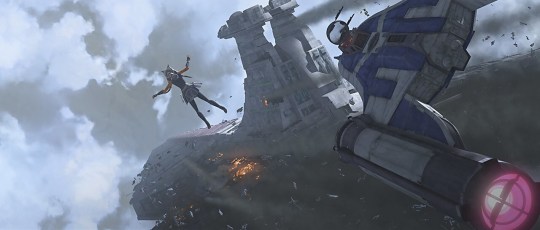


What About the Propaganda?
Returning to season 2, we come to the final big-picture takeaway of the "Lightsaber Lost" scenes: I’ve referred to Palpatine’s speech as something that plays in the background because Ahsoka doesn’t pay attention to his propaganda, even though it’s literally in her face. What does this mean if we treat Ahsoka as a stand-in for the Jedi, and Palpatine’s speech as a stand-in for his growing threat to the Jedi? In these scenes, Ahsoka first doesn’t pay attention because she’s trying to stay alive in precarious circumstances, just as Jedi across the galaxy are kept distracted from the big picture by trying to keep themselves, their Padawans, their troops, and civilians alive as war swallows up the galaxy. Then, Ahsoka is distracted by tracking the bounty hunter who has her lightsaber; in the context of this episode (which asks, ‘who should be allowed to use a lightsaber, and when?’), Ahsoka’s lightsaber also comes to represent Jedi’s efforts to fight the Clone Wars as ethically as possible. It presumably takes more time and effort to fight a war when you’re concerned with morals, at least when the opposition is perfectly happy to commit war crimes. By tossing the Jedi into a war, Palpatine keeps them too busy to systemically search for the Master Sith (in addition to Sith stuff diminishing the Jedi’s ability to use the force), as their time is eaten up by upholding the equivalent of the Geneva and Hague Conventions (etc.) when almost no one else is, by protecting as many other lives as possible, and by staying alive.
And The Clone Wars communicates all of this in a minute! Though I’ll admit my final point about Ahsoka’s lightsaber representing ethical combat is a stretch. I love it when TV shows and movies make full use of visual storytelling, and The Clone Wars is fabulous at it.
Whew—and that’s that! I’m grateful if even a single person has read this far and would love to know what you think, but regardless, I had fun analyzing this episode and organizing my thoughts about it. Cheers to the Clone Wars fandom.
#ahsoka tano#ahsoka#the clone wars#star wars#jedi#order 66#sheev palpatine#star wars meta#beloved jedi#skykind meta
115 notes
·
View notes
Text


vader's an awkward subject in the normal tl4j au, but it is SO much more awkward in the original trilogy au <3
(commission info // tip jar!)
#first dialogue is from agents of shield s1 (my beloved)#tl4j original trilogy au#ahsoka tano#cal kestis#luke skywalker#ezra bridger#bd 1#star wars#star wars rebels#jfo#my doods#the last (4) jedi
4K notes
·
View notes
Text
OP, I hope you don't mind me bringing the Clone Wars show into this, but it really supports your initial point.
Though it happens in a vision-like setting, Yoda also faces a similar test, which I think is a really fascinating! This is in the Clone Wars episode "Sacrifice," at the end of season 6. Pardon the messy screenshots—I'm not a gif maker or visual artist, but I think this is too cool not to talk about, even with my shoddy skills as our only option for visual examples.
In the episode's climactic scene, Yoda knows he's facing the cloaked master Sith, and believes he has a chance to discover his identity, but can't do so while also focusing on keeping a now-unconscious Anakin from falling to his death.




And then Yoda lets himself be hit by Palpatine's force lightning without defending himself, so he can focus on moving Anakin to safety; only when Anakin is in a safe location does Yoda go after Palpatine. Yoda is fully willing to put his own life at risk to discover the sith's identity, but he won't risk Anakin's. Yoda can make the choice to sacrifice himself, but he can't make that choice for Anakin—a young person in his care, and someone he personally cares about. Puts a more nuanced spin on attachment than we usually give Star Wars credit for (by which I mean this episode shows isn't attachment for Yoda to take the time to save Anakin).
Here's the cherry on top of this amazing sundae: the literal fall (engineered by Palpatine) that Yoda protects Anakin from simply to keep him safe—meaning he protects Anakin's well-being, not his utility in wartime—presages Anakin's later force-based fall to the dark side. Except Anakin will go on to make choices that are the complete opposite of Yoda's. So much going on here!
A visual parallel I have noticed throughout SW is the image of a Palpatine goading his new apprentice to kill a defenseless person. He does it with Dooku and Yaddle, Anakin and Dooku, and finally Luke and Darth Vader (Anakin). Each time he encourages them to do something that goes against their morals (killing a friend, a defenseless person, or their father) and the choice they make is telling to who they will become in the future. Luke is the person to break this cycle when he refuses to kill his father after seeing Vader’s mechanical hand. He looks to his own hand and realizes that to destroy his father is to become him. He holds fast to his ideals in the face of Palpatines attempts to change them. It’s a nice way to keep consistency with Palpatine’s character and form of manipulation.
3K notes
·
View notes
Text

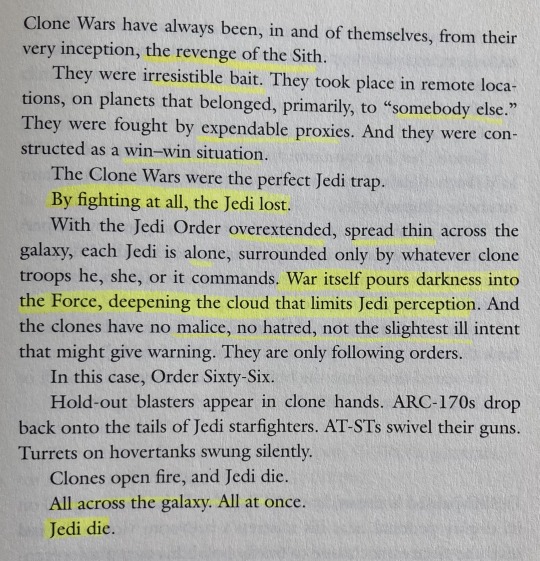
to me this is one of the most important passages of the revenge of the sith novelization, as it contains a fundamental thesis of the prequels. the clone wars were designed to kill jedi. sidious put the order in checkmate before they'd even begun fighting. he used their compassion and trust against them by leveraging their sense of duty to push them into fighting a morally dubious war to protect innocent lives, tarnishing their galactic reputation. he gave them friends in the clones that were crafted to become their assassins. he spread the jedi out, thinned their numbers in years of brutal combat, and then when they were sufficiently weak, wiped them out.
the revenge of the sith required so much planning and moving from the shadows over decades to arrange the galaxy into a trap. the prequel jedi did not have the knowledge that we the audience have, they were operating out of a place of partial understanding and with the best of intentions. to hold them to a standard of omniscience and omnipotence instead of appreciating the genius and patience of the sith is unfair and missing the point. they're not perfect, but they are good. it is tragic that being good is not always enough, it is tragic to know that our best of intentions can come up short. it is tragic that evil can gain power and harm the innocent without repercussions.
this book is heartbreaking on a personal level, but also on a political and ideological one. it reflects the very real world when greed and fear hold sway over a population, where exploitation and oppression win. the jedi are slain and it is brutal to read, and a generation afterward struggling in the dark without them. however, star wars ultimately carries a message of hope: you can kill jedi, but you cannot kill compassion and community. wherever people love each other, there is light. the empire fell and the jedi returned because you cannot kill their ideas. so there is hope, but that doesn't change that it is an egregious crime in the prequels that they were slaughtered.
#star wars#revenge of the sith my beloved#jedi order#sw#sorry this is wordy and long but i just have a lot of feelings about this goddamn book
3K notes
·
View notes
Text
So I did some math.
Kanan in Rebels says that, before Order 66, there were ten thousand Jedi protecting the galaxy.
Let's be extremely generous here, and assume he means ten thousand Jedi Knights. And let's take it a step farther and assume that this is at the end of the Clone Wars when the Jedi were streched thin, and that normally the number of Jedi Knights and Masters is higher. Counting the Corps, Padawans and the increased number of Knights, the number of able, field-ready Jedi could double the 10,000 Kanan mentions.
So, 20,000 fully-fledged Jedi. Half to protect the galaxy, the other half to restore planets, give access to free education, etc.
Of course, we're working on the assumption that none of these Jedi is permanently injured and unable to return to the field, or that they don't have duties to tend to in the Temple like taking care of the younglings. I'm, again, being very, very generous here.
There are a trillion people on Couruscant alone.
This makes the people's expectations (both in and out of universe) of what the Jedi should do absolutely laughable.
They're not enough people to invade a single planet, they aren't even enough to fill a fucking football stadium in my country. You want them to end slavery while also holding negotiations, diplomatic missions and be omniscient enough to know about the Sith Grand Plan? Be fucking real, man. They're streched thin doing everything they can.
My 140 people quirky Church hasn't solved human traffiking on our 7 billion planet population (same exact ratio btw). Should we stop giving soup and home-made clothes to the poor and focus on an impossible goal so that we don't stray from our purpose?
All my estimates have been extremely generous, almost to an extreme, and as such they are probably not very acurate. It's way, way worse.
And that's barely scratching the surface. On numbers alone, the Jedi cannot do any of the shit you want them to do. If we count permanent injuries and disabilities that may take Jedi out of the field, children, elders, archivists and others, the number becomes much more depressing.
#star wars#pro jedi#numbers my beloathed#yet also my beloved#I love that you can prove a point but you're difficult#in defense of the jedi
798 notes
·
View notes
Text
*after Mon Mothma’s briefing*
Wedge: Hey, Luke! So where’ve you been?
Luke: Yeah, so I went back to Tatooine to break Han’s ass out of Jabba’s Palace. I had to fight a rancor first, though. Luckily, I killed it before—
Omega, on the other side of the room: YOU KILLED MOOCHI?!
#she would NOT be happy that this kid she taught the tech turn killed her favorite rancor#rebel pilot omega my beloved#she knows everyone now lol#i love the headcanons that she and hera are his pilot aunties#star wars#return of the jedi#the bad batch#tbb spoilers#tbb season 3 spoilers#wedge antilles#luke skywalker#tbb omega#star wars incorrect quotes#tbb incorrect quotes#tbb finale
2K notes
·
View notes
Text
Alpha-17 has so much entertaining propaganda from his previous bracket that I feel like I need to talk up Tarre Vizsla, who is the better if less-funny choice to lead Mandalore in this round. Ahem…
For all that we don’t know much about Tarre Vizsla as a literal person, Star Wars has always been first and foremost a symbolic story, and boy does Tarre Vizsla pack a symbolic punch. He is multiculturalism incarnate, is remembered centuries later as a great leader, and wields a weapon that can be used to defend as well as attack. When he died, said weapon was laid to rest in the Jedi temple—a choice that can be read as Tarre wanting to stop Mandalore’s repeating cycles of violence—and the dark saber only became a symbol of might-makes-right leadership when other Mandalorians stole it from the temple.



Now, I would like to specifically address a particular through-line of Alpha’s propaganda as exemplified by the following statements: “Alpha-17 would be a great mandolorian leader I mean look at those Pecs! What else do u need in a leader?” and “Propaganda for Alpha 17: tall.”
We don’t know that Tarre Vizsla wasn’t sexy!! He could have been! Fact: most Jedi we see on screen are incredibly attractive. Fact: Tarre Vizsla was a Jedi. Therefore: Tarre Vizsla was probably also incredibly attractive. I rest my case.
ROUND TWO: MATCH-UP FOUR

Genuinely did not expect this one to happen, but here we go!
Remember, this is NOT about who would win in a fight. This is about who makes the best leader for Mandalore as a whole.
Explanation post
Seeding
Propaganda below the cut! You can submit more on this post and I will reblog it back to here!
TARRE VIZSLA
Anon: He was both a Jedi and a Mandalorian warrior. This means he had at least some knowledge of politics and how people work, and was a badass fighter. Both are important for leading a culture with a heavy focus on combat. He could also get advice from the Force, even if it was just a vague sense of whether or not something's a bad idea. (Also he was the one who created the darksaber, which isn't important on its own, but since it's his saber being used as a symbol of leadership, that implies he was at the very least a decent leader.)
ALPHA-17
@ihuntmonsters: He’s uhhh super badass and sexy and kicks ass and is really awesome and I’m in love with him Perfect propaganda yes. He shall lead Mandalore
Anon: He's pretty good with training children! He is very good at inspiring loyalty! He is very willing to go after sith lords with just his teeth if he has to!
Anon: Vote for Alpha he’s got Cody’s thighs, Fox’s tits and Wolffe’s ass. He’s also a DILF, if you consider the shebse squad/command batch headcanons. And who wouldn’t want a Mand'alor like that?
Anon: Alpha-17 would be a great mandolorian leader I mean look at those Pecs! What else do u need in a leader?
Anon: HERES WHY ALPHA-17 FOR THE WIN: HE WILL ASSASSINATE ALL OF THE OTHER POLITICAL FIGURES WHICH MEANS DEAD SKEVY SHEEVY PALPATINE AND WHO DOESNT WANT THAT?
Anon: What a guy. I love him so much. He's such an asshole. Alpha-17 was part of the second test batch of clones of Jango Fett, one of a group of 100, and as such he was trained directly by Jango Fett in the art of war; these early batches who had more contact with their Mandalorian trainers are commonly considered to have a stronger claim to 'Mandalorian-ness' because of this exposure and learning experience than clones from the later, larger batches
Anon: Propaganda for Alpha 17: tall
Anon: Alpha-17 should rule Mandalore because a good king doesn’t want the power of the throne and he does not want that at all. also he’s the funniest choice. might have the skills to not get killed by maul
NEW: @ihuntmonsters: more propaganda for alpha-17: - he takes no shit from anyone he will kick ass - sassed obiwan the sassmaster multiple times - oh god oh god oh god oh god i love him i love him i love him
74 notes
·
View notes
Text
how the fuck are you mad about mace windu not trusting anakin in revenge of the sith…..did that mf not prove his ass RIGHT???
i agree with everything he fucking said with regards to anakin in that movie! it’s the truth!
#pro jedi#mace windu appreciation#“take a seat young skywalker” so real#they could never make me hate you jedi master mace windu my beloved !#don’t waste time trying to argue with me…i promise you….i do not give a fuck
211 notes
·
View notes
Text

Since I'm free from exams here's a very quick Jecki Lon 🥺
563 notes
·
View notes
Text

I love the gag that Kit Fisto just really loves swimming at any opportunity and will walk around shirtless, completely oblivious.
#artists on tumblr#digital art#star wars#star wars fanart#star wars fangirl#obi wan fanart#obi wan my beloved#obi wan kenobi#kit fisto#just walks into Jedi council meetings after a swim#Jedi#jedi knight#headcanon#origional work#a long time ago#star wars kenobi#general kenobi#hello there#kitfistomeme
2K notes
·
View notes
Text
The Clone Wars: Interpreting Key Scenes About Attachment in Seasons 1 & 6
In which Anakin goes full damsel-in-distress, and Ahsoka and Yoda repeatedly save his bacon
Attachment—every Star Wars fan’s favorite stress-free topic, right?? Well, I’m pleased to offer you a measured post that analyzes the thoughtful and generous-hearted explanation of attachment provided by The Clone Wars in the season one episode "Jedi Crash" (S1.13) and the season six episode "Sacrifice" (S6.13). "Jedi Crash," chock full of teachable moments as it is, both demonstrates and has characters explain a particular nuance of the Jedi’s in-universe beliefs about attachment, while the more mature and subtle "Sacrifice" shows Yoda implement this belief without explicitly addressing attachment as a topic.
So, what nuance does the pair of episodes explore? The Jedi are not in the business of sacrificing lives. Not the few, not the one, even for the many. Not if there is any other good and just path left open to them—no matter how difficult that path may be. Which is actually to say, the only life a Jedi is truly prepared to sacrifice is their own.
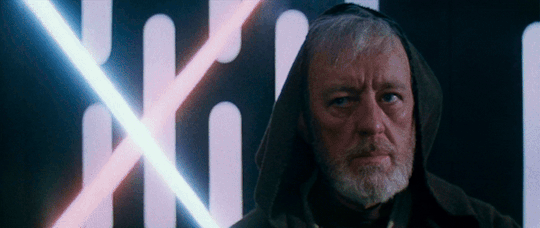
This refusal to sacrifice others relates to the Jedi Order’s beliefs about attachment because characters who Jedi personally care about are regularly in peril throughout The Clone Wars and other parts of canon, and sometimes as the “few” rather than the “many.” "Jedi Crash" and "Sacrifice" show how Jedi navigate having personal relationships and upholding their commitment to saving as many lives as possible.
It takes until the season six episode for the show to fully explore this topic, as it’s a bit bleak in the context of a pending genocide committed by a Jedi (Anakin) who both fails to grasp the concept of personal sacrifice and who falls for the trap of a false dilemma in the context of attachment. Please read the following definition, as false dilemmas also play a role in a test Yoda faces in "Sacrifice."
Definition: False dilemma "A false dilemma, also referred to as false dichotomy or false binary, is an informal fallacy based on a premise that erroneously limits what options are available. The source of the fallacy lies not in an invalid form of inference but in a false premise."
I’m going to spend most of my time on the more complex and beautiful "Sacrifice" (S6.13), but "Jedi Crash" (S1.13) still has interesting things to say and provides an important foundation for both this essay and "Sacrifice" itself.
Season 1: Young Ahsoka Grapples With the Meaning of Attachment
Fans who take it upon themselves to explain the Jedi Order’s canon approach to attachment often nod to a series of conversations between Ahsoka and Aayla in S1.13, or what I think of as the Intro to Attachment episode. I’ve seen some fans make their task harder by leaving out a crucial implication of the following statement, spoken by Aayla: "Don't lose a thousand lives just to save one." What are fans missing about this statement in the context of "Jedi Crash"?
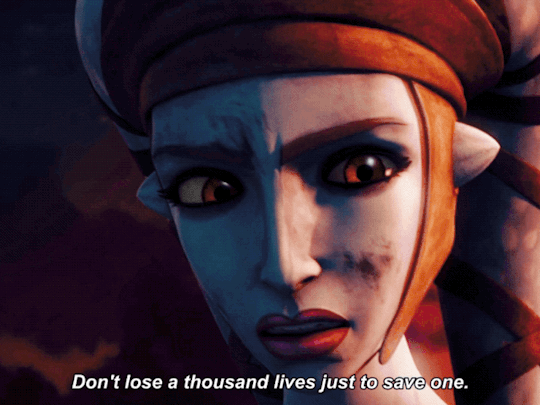
Nothing about it says a Jedi's first goal shouldn't be saving 1,001 lives in this hypothetical scenario. Save both the one life and the thousand. Just don't lose a thousand to save one. It's a shame that some fans out there in the attachment trenches don't seem to have picked up on this distinction, because I instead see folks using the following as an example: Jedi should be willing to sacrifice one life to save the thousand. That's not the first step!
Step one: aim to save all lives. Step two: if forced to choose by circumstance, prioritize the many over the few, even if the few includes those a Jedi loves.
In the opening scenes of "Jedi Crash," Ahsoka saves Anakin's life by going back for him when he would otherwise have died in the explosion of Aayla's Venator, and she then contributes to saving a group of lives that were simultaneously on the line as Anakin's hung in the balance. The narrative doesn't criticize her decision to return for Anakin, as step one—"aim to save all lives"—is an option at the time and the correct path to take.
It is only when prioritizing Anakin's wellbeing would condemn many other people that the show, via Aayla, criticizes Ahsoka's choices. After Ahsoka rescues an injured Anakin, she doesn't want to leave his side to provide some of the help I mentioned in the above paragraph; she also doesn't want to divert power from Anakin's life support to the smaller ship the group is escaping on. Without that diverted power, the ship would have crashed into a star—and everyone aboard would have died. Because Ahsoka is simply an overwrought teenager and not actually evil or foolish, Aayla manages to talk sense into her and Ahsoka helps the ship avoid the star and land on an unidentified planet.
This is not her last brush with attachment in the episode; Ahsoka doesn’t wish to leave a still-injured Anakin behind—to be guarded by Rex—when Aayla orders the bulk of the group to search for assistance, even though Ahsoka staying with Anakin would rob the group of her skills at a time when they’re in serious need of help.
Aayla again gets through to Ahsoka, and they proceed to have their conversation about attachment while on the road; this conservation includes Aayla’s key line, "Don't lose a thousand lives just to save one."
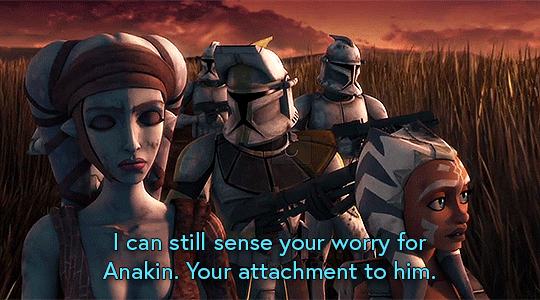
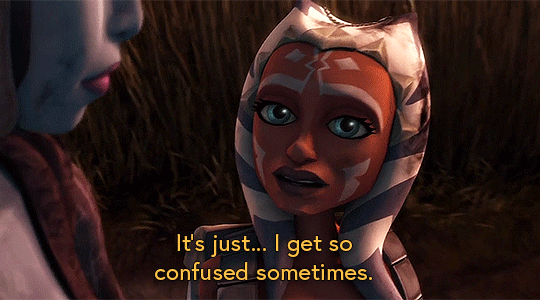
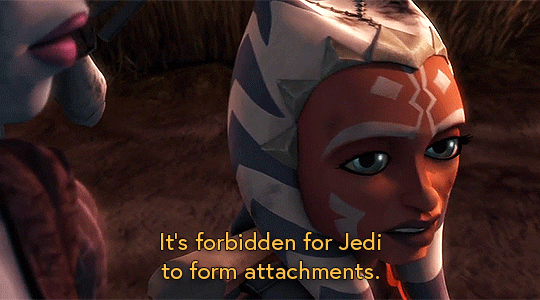
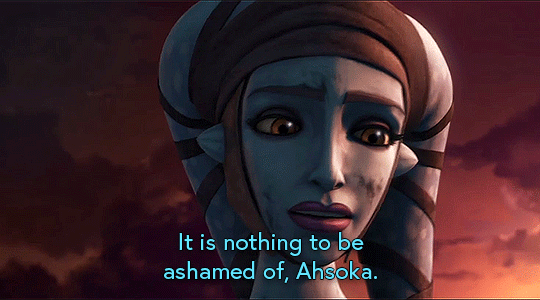
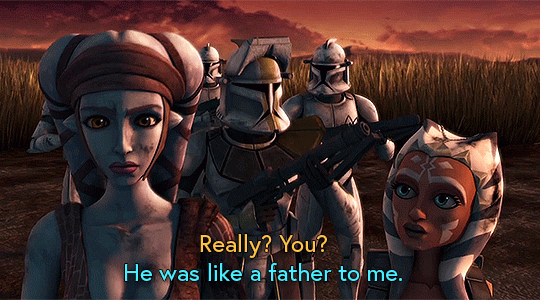
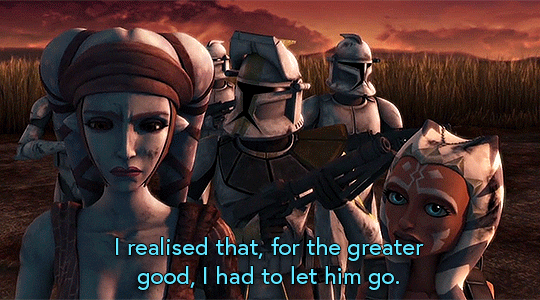
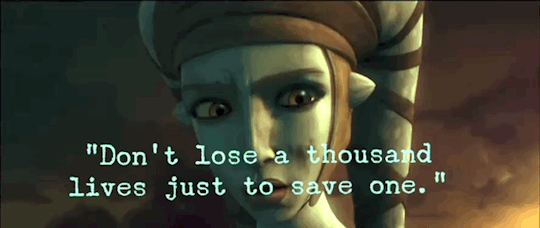
How does a still-learning Ahsoka reply to this line? She says, in a doubtful tone, "Maybe, but that doesn't mean that I can't try to save his life."
Ahsoka, you’re right, that doesn’t mean you can’t try to save his life, but you’ve got to apply some parameters so you don’t condemn a bunch of other people instead—meaning you also need to listen to Aayla.
Crucially, we later see that by setting aside her obsessive worry for Anakin and taking "step two" as I outline it above ("if forced to choose by circumstance, prioritize the many over the few") on the planet the escape ship lands on, Ahsoka actually accomplishes "step one": everyone lives! Anakin survives—the one life—because they find a village that's home to a medic, and Ahsoka helps save their GAR contingent and the villagers (as of the next episode)—the thousand.
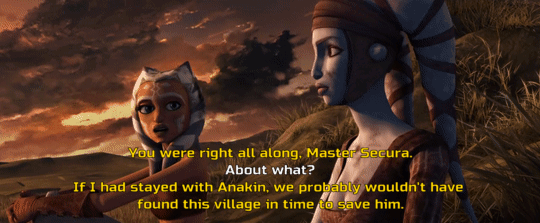
Ahsoka: "You were right all along, Master Secura." Aayla: "About what?" Ahsoka: "If I had stayed with Anakin, we probably wouldn't have found this village in time to save him [from his injuries]."
Season 6: The Morality of Sacrifice
Season six's "Sacrifice" (S6.13) isn’t overtly about attachment, but it provides a case study for the “save all lives whenever possible including people you personally care about” model laid out by "Jedi Crash" without belaboring the point. By which I mean, there’s no heavy-handed dialogue.
Like the season two episode I analyzed in my first meta post, “Sacrifice” is saying three things at once, but unlike in “Lightsaber Lost,” these narrative strands are closely intertwined.
The literal plot: Yoda faces and passes a test so he can learn to be a force ghost.
The dramatically ironic metaphor: the time of the Jedi in a galaxy far, far away and in the galaxy we call home is drawing to a close (one week after The Clone Wars’ fifth season ended in March 2013, Lucasfilm announced the show was being cancelled; the show's sixth and then-final season was released in March 2014).
The morality tale for all ages, but particularly older audiences: We can’t control the advent of certain painful and inevitable endings, but we can control how we respond to them. The choices we make, the way we live, even the way we die—they matter. (Anakin is going to fall.) (And someday, Anakin is also going to return to the light.)
I will only be analyzing small portions of the first and third points, but wanted to lay out all three, if simply to show just how much this remarkable episode has to say.
“Sacrifice” concludes a three-part arc in which Yoda must pass a series of tests proving him ready to learn the secrets of Jedi-style immortality from the deceased Jedi Master Qui-Gon Jinn, who says he lives on, ghost-like, as part of the living force. "Sacrifice" contains Yoda’s final and most dangerous test.
In the episode’s climactic scene, Yoda faces the cloaked master Sith in a vision, and believes he has a chance to either discover Sidious’ true identity (i.e., that he’s Palpatine) or defeat him and thus help end the war for the good of the galaxy. He can’t do so, however, while also focusing on keeping a now-unconscious Anakin from falling to his death. If Yoda prioritizes Anakin’s life in this moment—by taking the time and energy to place him somewhere safe—instead of immediately pursuing Sidious, does that mean Yoda is attached to Anakin? Or is saving Anakin’s life part of an ethical path forward Yoda must discover? Let’s find out as we face Yoda’s test alongside him!
Long stretches of this episode have little or no dialogue, and understanding “Sacrifice” often depends on interpreting characters’ facial expressions and actions, and analyzing symbolism. This makes the episode hard to summarize, and the act of summarizing risks becoming an act of interpretation. As I want us all to start on the same footing, I’m going to provide direct quotes from the canon starwars.com summary alongside screencaps, rather than write an overview myself. I also just like the official summary: it’s very evocative, and likely draws from the script.
Summary
In this episode, Yoda travels to the "Valley of the Dark Lords" on the abandoned Sith world of Moraband. He tussles with some Sith spirits, and then…

'In the dark tomb on Moraband, Yoda enters a large chamber where the ancient Sith would sacrifice Jedi. The five Priestesses emerge before him and warn Yoda that the next trial is not of their doing — it is instead created from the absolute darkness of this place, and it is not under their control.'
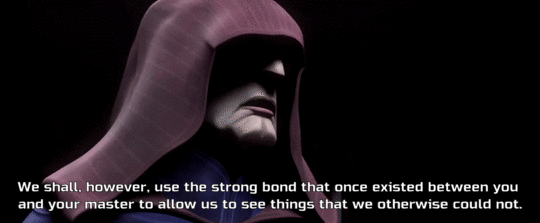
'On Coruscant, in a ceremonial chamber lined with statues, Sidious leads Dooku to a sacrificial altar basin. Sidious knows that Yoda is on Moraband. The Dark Lord explains that the strong Force-bond between Yoda and Dooku can be exploited to reach out through a ripple in the Force. 'Producing a knife, Sidious cuts Dooku's hand, allowing a single drop of blood to fall into the water-filled basin. He and Dooku together zap the water with their Force lightning, while Sidious recites an ancient Sith incantation in the Balc tongue. Sidious dips his face toward the basin. He now wields the power of dark illusion, and will lead Yoda into a trap.'
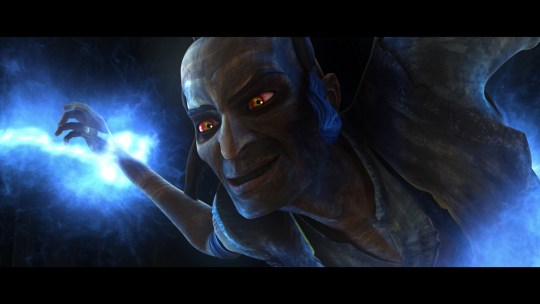
'In the Moraband execution chamber, Yoda sees the withered form of Sifo-Dyas chained by lightning shackles to stone pillars. He begs to be released, offering in exchange the identity of the Sith Lord. Sifo-Dyas' mad eyes shine red and yellow. Yoda refuses the offer. Sifo-Dyas suddenly transforms into a cackling Sidious, and Yoda is surrounded by chains of energy. 'The Jedi Master suddenly awakens in the hold of a gunship, flanked by clone troopers of the 501st and Anakin Skywalker. Yoda is disoriented; he is in the midst of a mission. Anakin explains that a rogue shuttle slipped past the Coruscant security grid, and has been tracked to the industrial sector.'
Summary of the summary: They believe Dooku is on the shuttle, and traveling to meet the Sith Master. At last they can discover who is behind the war! Yoda orders the 501st to pursue, and they follow the shuttle to an abandoned building in a Coruscant industrial district. ‘The Sith must not be allowed to escape. They must be executed.’ Anakin duels Dooku while Yoda pursues Sidious. Anakin ends up injuring and then beheading Dooku, just as he will in the future.
I'm now going to flip the order of the screenshots (plus the one gif I could find) and the quotes from the official summary as we take a detailed walk through the episode's climactic sequence. Putting them in this order really adds an element of dread.
'Sidious flees to a catwalk extending from the tower, and Yoda gives chase. The Dark Lord lights his blade, the two Masters engage in a whirling duel. Anakin rushes out to help Yoda, but runs headlong into a Force grip wielded by Sidious.'
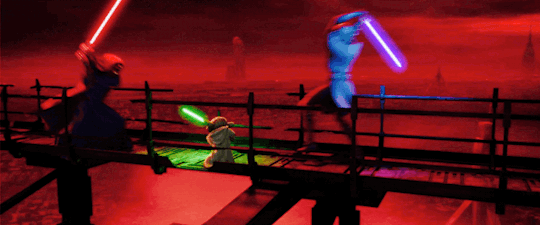
'Sidious blasts Anakin with Force lightning, sending the young Jedi crashing to the catwalk in a heap.'
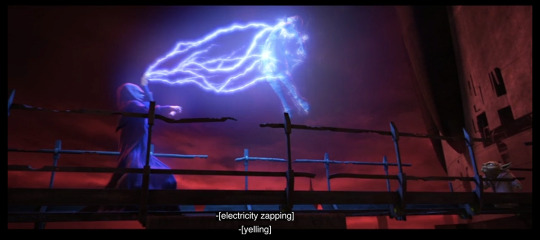
'He then blasts Yoda, who blocks the lightning with the Force. The discharge of energy rattles the catwalk.'
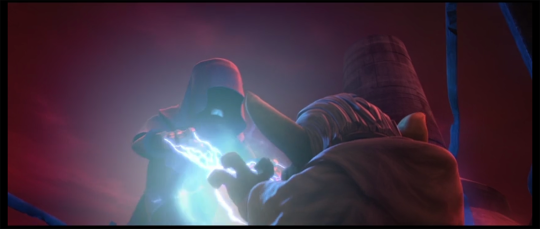
'Sidious uses his lightsaber to cut the support beams of the catwalk.'
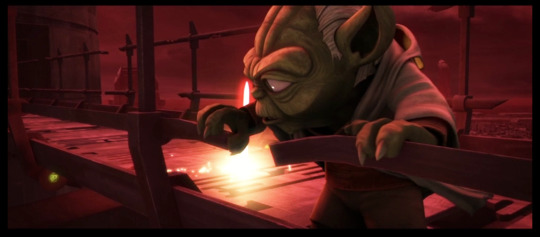
'The structure starts to collapse.'
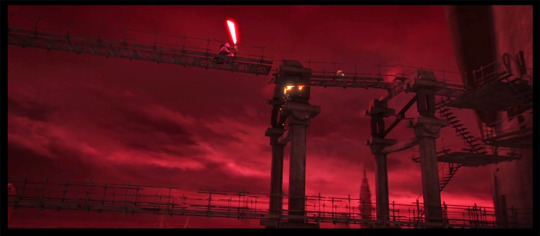
'As it cants forward, Anakin's unconscious body slides towards a deadly fall.'
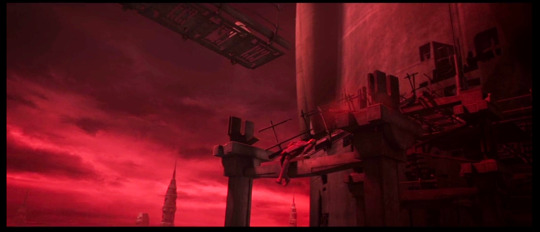
'Yoda halts his pursuit of the Dark Lord to catch Anakin with the Force.'
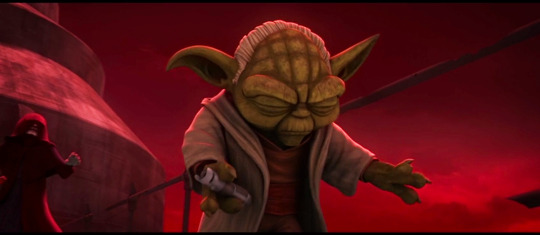
'Sidious cackles at Yoda's predicament. Sidious tells Yoda to let Anakin fall, and thus thwart all of the Dark Lord's plans. Yoda refuses.'
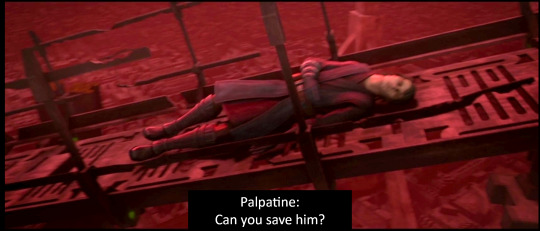
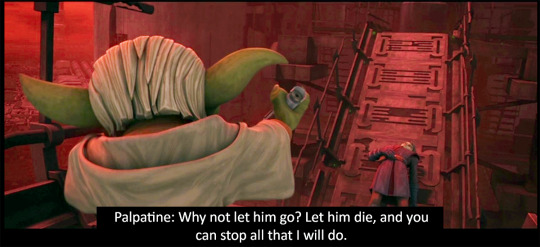
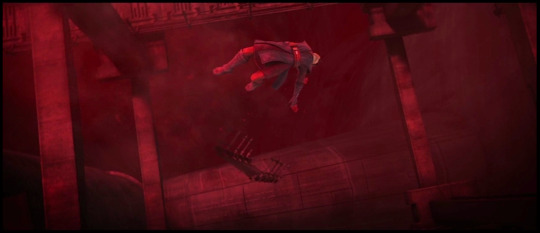
Palpatine: "Can you save him? Why not let him go? Let him die, and you can stop all that I will do."
Close Reading and Analysis
Palpatine taunts Yoda with the choice before him—though it isn't a true choice, of course. This is a vision controlled by a Sith, and Palpatine’s goal as the vision’s mastermind is to weaken Yoda by undermining his moral code and drawing him to the dark side. Regardless, the vision feels real to Yoda, and he’s been presented with two options: save Anakin, or let Anakin die so he can “stop all that [Palpatine] will do.”
The choice serves two storytelling purposes: as presented by Palpatine, it represents temptation and a test for Yoda, while the broader narrative presents it as a teachable moment for the audience. Is it right to prioritize the life of a single person in this moment, when Yoda thinks there’s a chance he could stop the Sith?
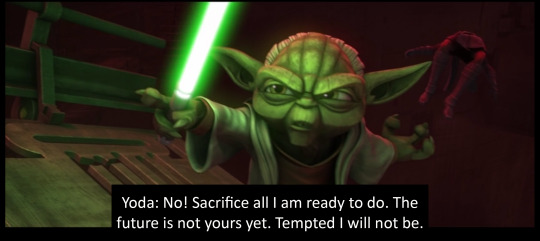
Yoda: "No! Sacrifice all I am ready to do. The future is not yours yet. Tempted I will not be."

We get our answer when Yoda says “No!” and lets himself be hit by Palpatine’s force lightning without defending himself, so he can instead focus on moving Anakin to safety; only when Anakin is safe does Yoda go after Palpatine.
When Palpatine taunts Yoda about the choice he needs to make, he actually establishes a false dilemma, “an informal fallacy based on a premise that erroneously limits what options are available." Yoda begins to pass his test by finding a third way forward. He has one other good and just path left open to him, and he takes it—and the path proves difficult indeed.
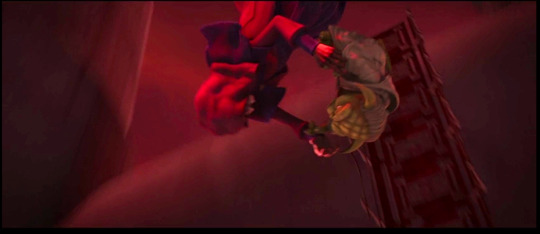
'Yoda hurls his lightsaber at the remaining struts of the catwalk, collapsing it, sending he and Sidious tumbling to their certain doom. Yoda grapples with Sidious as they fall, the Dark Lord cackling all the while.'
This third path allows Yoda to first save Anakin—in a matter of seconds—and then pursue the Sith, but the circumstances of his showdown with Palpatine are now more dangerous than they might otherwise have been, given that in the leadup, Yoda took a full blast of Force lightening without attempting to block it, and the catwalk sustained further structural damage.
My post’s introduction covers Yoda’s choices in broad strokes: “The Jedi are not in the business of sacrificing lives. Not the few, not the one, even for the many. Not if there is any other good and just path left open to them.”
There are still nuances to unpack, however, so let’s turn to a crucial moment of dialogue from the episode:
Palpatine: "Can you save him? Why not let him go? Let him die, and you can stop all that I will do." Yoda: "No! Sacrifice all I am ready to do. The future is not yours yet. Tempted I will not be."
I want to touch on one part of this exchange: The writers chose to have Yoda say he is ready to sacrifice “all” when we’ve established he is quite unwilling to sacrifice Anakin.
This dialogue suggests Yoda has set firm limits around the concept and ethics of sacrifice. He is both willing to sacrifice whatever meets his definition of “all” and clear Anakin isn't part of this “all”—given that he almost literally holds Anakin’s life in his hands during this scene and could therefore easily sacrifice Anakin. Instead, Yoda chooses to focus on keeping Anakin from falling.
So how does Yoda define “all”? Heartbreakingly, he exemplifies another point I made earlier: “… the only life a Jedi is truly prepared to sacrifice is their own.” This episode signals over and over again that it is about both sacrifice and choice—and the ethics thereof. Yoda can make the choice to sacrifice himself to defeat the Sith, but it would be unethical and un-Jedi to sacrifice Anakin, a young person in his care, and yes, someone he personally cares about.
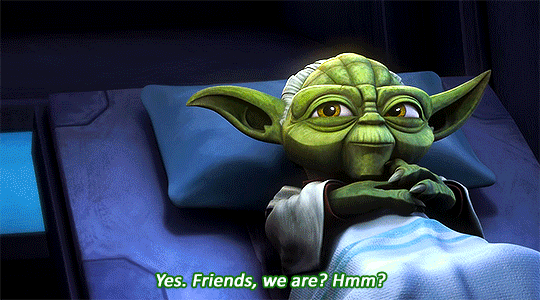
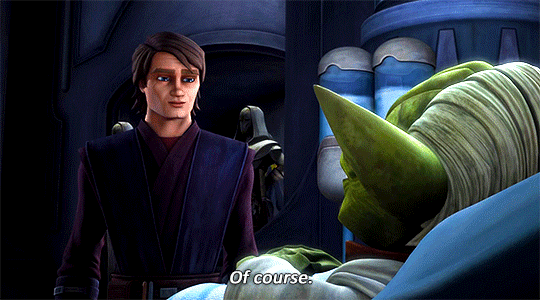
This means it isn’t a sign of attachment that Yoda takes the time to save Anakin. It is instead a sign of boundless love, generosity, and sacrifice. It is the action of a true Jedi.
Even the Sith Master himself confirms this when he leaves the vision and says to Dooku, "We have failed to break Master Yoda. He is strong. We will need more time if we are to defeat him and the Jedi."
I have to take a moment to note one of the great uses of symbolism in this episode: Palpatine engineers Anakin's literal fall that Yoda protects him from in the previous sequence, and it presages Anakin’s later fall to the dark side. Except Anakin will of course go on to make choices that are meaningfully the opposite of Yoda’s when Palpatine tempts Anakin and presents him with a false dilemma in Revenge of the Sith.
Conclusion
And with that note, it’s time to start wrapping up this very long post. Ultimately, there are three key things I really like about the way “Jedi Crash” and “Sacrifice” present the Jedi’s beliefs about attachment: they canonically and clearly make space for Jedi to have warm, healthy personal relationships, and go so far as to say it would be a dark act for Yoda to sacrifice Anakin; they counter some of fandom’s most cruel headcanons about Yoda (I’m not getting into that here); and they provide a useful framework to evaluate Anakin’s choices in Revenge of the Sith.
In the film, Anakin had a third and more difficult path available to him that he chose not to take. Rather than choosing between Padme’s survival or the Jedi and the Republic—the two sides of his false dilemma—he should have tried to simultaneously save Padme’s life, the Jedi Order, and democracy.
Given that Anakin himself is responsible for Padme’s death and the fall of the temple, his choices have enough impact on key events to determine whether or not this third path results in a brighter future—one where many more people survive, Padme and at least some Jedi among them. This third path, this brighter future, must be in reach from a narrative standpoint for Anakin’s test to be a true one. But while Yoda and Luke pass similar tests (Luke a few decades in the future), Anakin fails his, and so Padme, the Jedi, and democracy die—due in part to Anakin’s inability to master the nuanced beliefs about attachment and self-sacrifice laid out by “Jedi Crash” and “Sacrifice.” Side note: Jedi first aim to save as many lives as possible, and so no true Jedi would have argued against saving Padme’s life regardless of her relationship with Anakin.
Back to "Sacrifice," as Yoda awakens from his Sith-led vision...
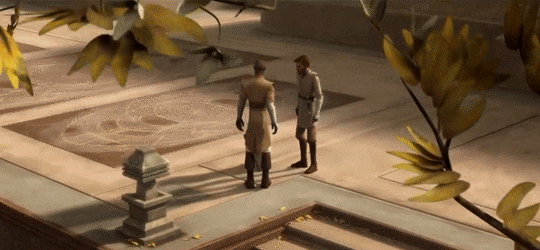
'The serene Priestess welcomes him. He has passed this challenge... As the Priestess disappears in a glow of light, Yoda sees the future, including the moment of his death and his own last words. '... soon, Yoda stands beneath the great tree at the Jedi Temple. Mace Windu and Obi-Wan Kenobi approach Yoda, so he can report to the Jedi Council. But Yoda cannot say much of his journey. He senses the war's end approaching, and knows there is no victory to be had in the Clone Wars. But another path to victory lies ahead for the Jedi, a path that is unknown to the Sith.'
At this point perhaps a year before the genocide of the Jedi, Master Yoda's learning-to-become-a-ghost journey and a vision of his death — "There is another Skywalker" — combine to give him good reason to believe some hope remains for at least a few Jedi and their allies.
Here's what Yoda says to Mace and Obi-Wan, and it's crucial that they're the only other characters in this scene: “Yes, open to us a path remains that unknown to the Sith is. Through this path, victory we may yet find. Not victory in the Clone Wars, but victory for all time.”
These three Jedi, the leaders of their people, can choose a narrow, barely there third path on behalf of the Order, and they must take it — no matter how agonizing it proves to be. No matter how much they must sacrifice to walk it. (And in the meantime, they’re not shirking other major duties: they’re still fighting for the best possible present and future for the Order and the galaxy, still leading the Clone Wars and trying to find out Sidious’ identity.)
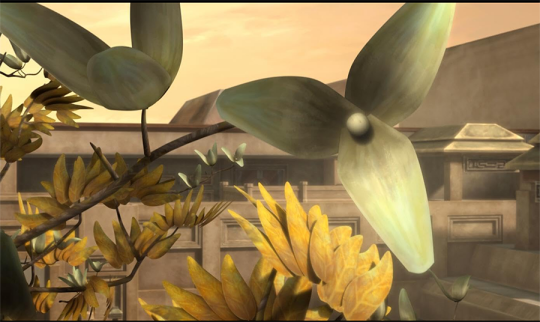
As the episode “Sacrifice” draws to a close, it visually highlights a three-petaled flower that symbolically blooms as a sign of new hope for the Jedi who will soon travel this third path. Each petal represents one of the Skywalkers who will finally see the Sith defeated and democracy restored to the galaxy: Leia, Luke, and Anakin/Vader, in the moments he returns to the light.
They will one day anchor the end of the pathway, each connected to the others (through biological and sometimes chosen relationships) as the petals are connected in the flower, and that’s plenty of symbolism to be getting on with, but then! The flower ends up being an even stronger sign of hope and connection, as the three petals are also a metaphor for Yoda, Mace and Obi-Wan.
These three Jedi anchor the beginning of the pathway with hope clutched in their hands, each connected to the others by shared culture, shared experiences, friendship, and respect. And in the final days of the war and during Order 66, they go a step beyond connected: they are united by the bravery they each demonstrate, the sacrifices they each make, and the impact they each have on the galaxy.
And so, this lovely episode closes on a scene of sacrifice, hope, and human connection.
#star wars#the clone wars#ahsoka tano#ahsoka#anakin skywalker#sheev palpatine#yoda#aayla secura#jedi#jedi order#star wars meta#TCW#sw meta#jedi temple#beloved jedi#skykind meta
10 notes
·
View notes
Note
first time I've ever sent in an ask on tumblr lol, I just had to inform you that you're such a huge inspiration to me, you're art is incredible and please keep doing what you're doing!!
you feed me dinluke content and I'm eternally grateful 🙏🙏
I think it'd be so fun if ahsoka passes on the Anakin Skywalker Chaos to grogu whilst din is either just exhausted or desperately trying to calm him down for just two seconds please grogu the mans tired
aw I'm flattered I'm the recipent of your first ask!! here have some more dinluke (maybe after finally getting grogu to calm down lol)

#mand'alor n master jedi dinluke my most beloved. greatest dynamic ever#dinluke#luke skywalker#din djarin#the mandalorian#thanks for the ask!#askbox closed#my doods#mand'alor din djarin
921 notes
·
View notes
Text
Here’s 52 seconds of Mark Hamill being a dork because I can and I will 🫶🏻✨
#mark hamill#star wars#he’s such a dork#kinda gives off twink energy too#but we don’t talk about that#also how is this man also the joker#luke skywalker#luke my beloved <33#a new hope#empire strikes back#return of the jedi#star wars original trilogy#scifi#fantasy
629 notes
·
View notes
Text
Every friend group Jedi Lineage should include:
A bimbo:
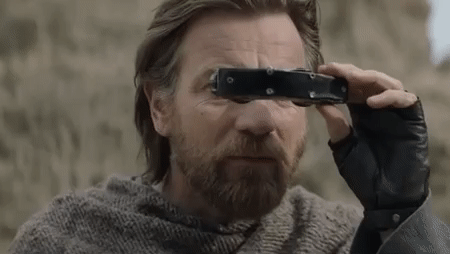
A mean bisexual:
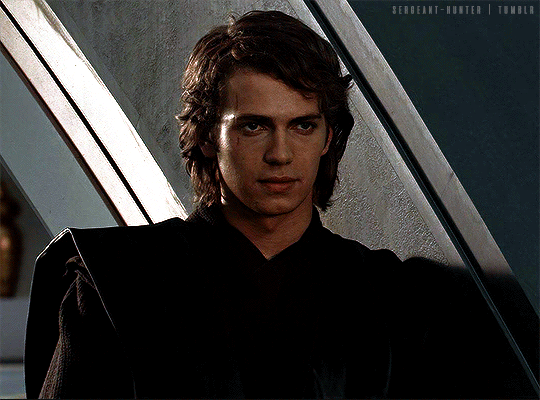
An even meaner lesbian:
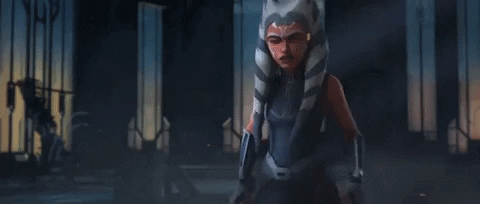
She/theys:
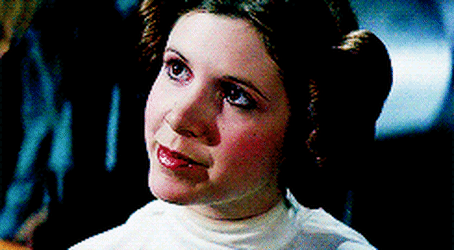
He/theys:
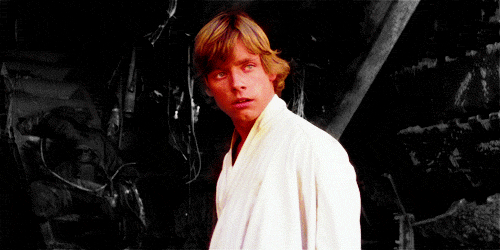
A token straight that’s on thin ice:
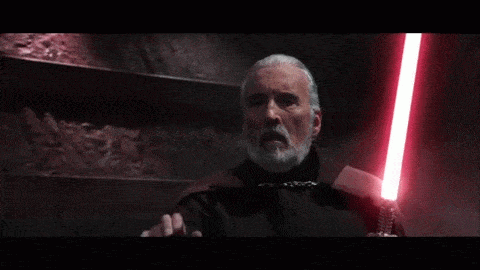
An astrology bitch who has everyone’s birth chart memorized:
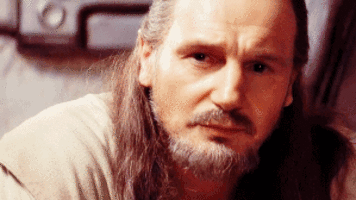
A short king:
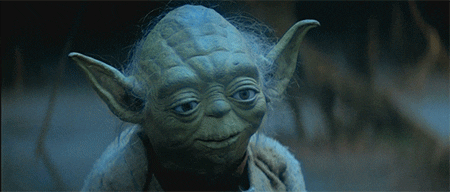
#Every friend group should include#Every Jedi Lineage should include#funny#obi wan my beloved#star wars#star wars the clone wars#obi wan kenobi#Qui-Gon Jinn#Yoda#master yoda#Count Dooku#Luke Skywalker#leia skywalker#leia organa#Ahsoka Tano#Anakin Skywalker#star wars headcanon#star wars prequels#star wars disaster lineage#disaster lineage
4K notes
·
View notes
Note
Do you have any advice for writing Mace Windu?
Hello friend! I've been sitting on this for a while, because everyone's got their own interpretations, but mine is based on an idea I was struggling to put words to.
(Caveat that I have not read Legends material, that people can write what they like, etc. etc.)
The way I see it, Lucas specializes in writing stories in terms of themes and archetypes. This is why certain dialogue choices or the development of certain relationships can be... clunky, let's go with that. Characters (Obi-Wan and Anakin fall into their own category, sure) are written primarily as archetypes. You have Yoda as the wise old sage, Sidious as the ultimate evil-
And Mace Windu as the ultimate good.
We see this in the Chancellor's office, right? During the final showdown. This is the moment where Anakin makes his choice- stay in the Light or Fall- and the characters visually representing that choice are Palpatine and Mace. He's the Master of the Order. He's raised a Padawan who sits on the Council with him. He's an incredibly skilled swordsman- hell, his fighting style of choice (Vaapad) epitomizes how clearly he's mastered the art of internal balance!
All of that to say- his whole character is built around the idea that he is the Good Guy. That would be the one piece of writing advice I would give. If you're wondering how to write him, start with that idea- that he is written to represent the absolute opposite of Sidious. He's the ultimate good. He is the illuminating Light to Sidious' corrupting Dark. This is why antagonistic portrayals of him never ring true to me- they're coming from a foundational understanding that I simply do not subscribe to. It reeks of a fundamental misunderstanding of his character and of the whole saga's themes.
(And also racism. I'd be remiss if I didn't mention the racism that too often plays a significant role.)
All of that being said, what might it look like to write from the foundation of Mace being the representation of ultimate good? The good thing about characters being written as archetypes is that it gives us fans a significant amount of freedom in determining what those characters look like when they're written as characters. Different people will have different takes, but for me:
Well, first off- he's the epitome of a Jedi. So all of what that entails- he is fundamentally kind, fundamentally compassionate, and fundamentally in control of himself.
He's funny. I think he has a very dry sense of humor, and that he finds joy in the smallest things.
He loves so much. He loves his Padawan, he loves his friends, he loves his family, he loves the Republic- he loves the galaxy enough to go to war for it, and he loves the men who'll kill his people.
There will never be a situation where he has the capacity to help and chooses not to.
And last but not least, I choose to believe that this man can bake pastries with the best of them. In my heart of hearts, he's a stress baker, and he mends his socks with purple thread.
Hope this helps!
#pro mace windu#mace windu my beloved#i love him i love him so much#thank you for giving me a chance to ramble on about exactly how much!!#pro jedi#pro jedi order#mace windu only made one wrong decision in his life and that was trusting anakin#and even then he was only wrong because anakin let him down!#anakin was not worthy of the trust mace placed in him!!#and that's not mace's failing#it's anakin's
339 notes
·
View notes
Text
"Luke is different from the dogmatic PT Jedi! He saved his father with his attachment!"
Wrong. Luke didn't save Vader with his attachment, Luke saved Vader with compassion. Y'know, the unconditional love that is central to every Jedi's life.
Luke being attached to Vader would imply that Luke needs his father in his life to be happy. It would imply that, when Anakin asked his son to take off the mask, Luke wouldn't do it and would keep dragging Anakin to the shuttle. Perhaps that would have saved his father's life.
Attachment, despite looking like love on the surface, is not only a different thing, it's love's complete antithesis! Attachment is selfish, self-centered, it focuses more on your happiness than the other person's wellbeing. It's fear of loss, greed of wanting to stop the inevitable, and anger and hate when it eventually fails.
But… Luke doesn't do that. Luke stops and listens, and follows with his father's last request. In a way, you could argue that Luke killed Anakin, because he took off the life support that prevented Vader from dying. Luke does that because he respects his father's wishes, what his father wants, and puts it above his desire to have his father in his life.

When Anakin dies, Luke grieves for him, mourns for his father and for a life lost because he's that much of a saintly, kind-hearted soul.
But then he sees the Force Ghosts of his father and his Jedi Masters.

Luke smiles, his spirits lifted, and joins Han, Leia and the rest of the rebels on the celebration.

Because that's what compassion, true unconditional love is, not needing people in your life, being able to be happy without them, but loving and caring for them anyways.
That's what the Jedi believe, and that's what Luke embodies more than anything else.
#pro jedi#luke skywalker#pro jedi code#pro jedi order#jedi positivity#love vs attachment#attachment isn't love#luke is a saint tbh#luke skywalker my beloved#I relate a lot to him in ANH and ESB as someone who's always looking at the horizon and wants something more#watching him come back in ROTJ as a Jedi Knight utterly wrecked me
201 notes
·
View notes